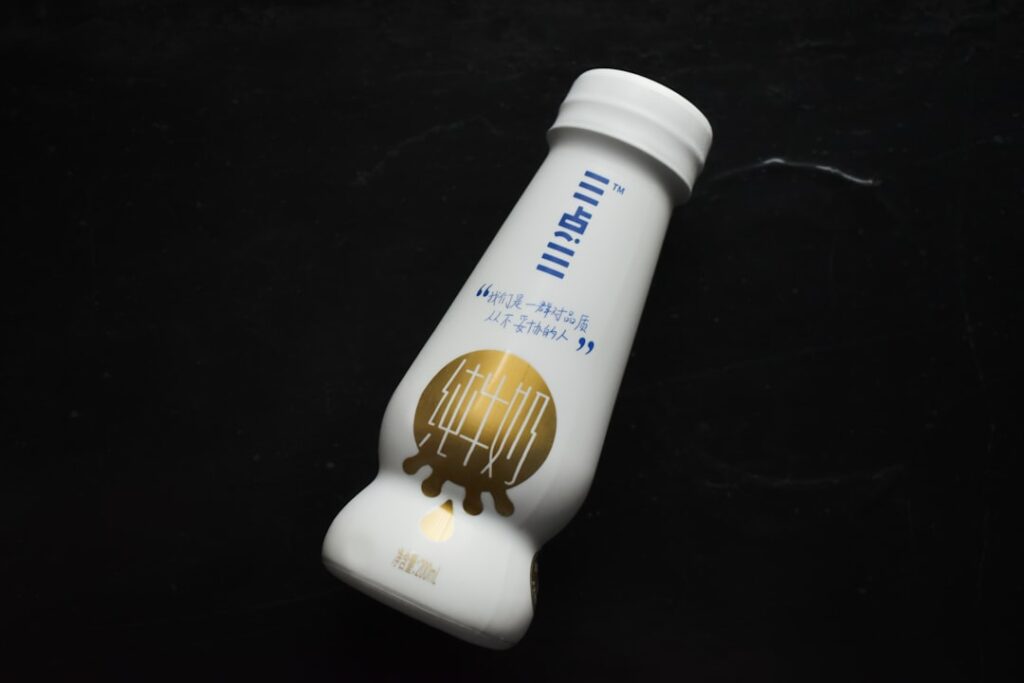Why Tretinoin Cream Is the Gold Standard for Skin Change
Tretinoin cream is a prescription vitamin A derivative that has been the dermatology gold standard for nearly 50 years. This powerful retinoid works by speeding up cell turnover and promoting collagen production to treat acne, fine lines, and hyperpigmentation.
Quick Facts About Tretinoin Cream:
- What it is: All-trans-retinoic acid (synthetic vitamin A)
- FDA approved: Since 1971 for acne treatment
- Available strengths: 0.025%, 0.05%, and 0.1% cream formulations
- Primary uses: Acne vulgaris, anti-aging, dark spots, skin texture
- Results timeline: 2-3 weeks for initial changes, 12 weeks for visible improvement
- Prescription required: Yes, available through dermatologists or telehealth
Not long ago, getting tretinoin meant “scheduling an in-office dermatologist visit, waiting weeks for an appointment, and sitting in a fluorescent-lit waiting room.” Today, telehealth has made this powerhouse ingredient more accessible than ever.
Tretinoin works at the cellular level by decreasing the stickiness of skin cells and increasing their renewal rate. This process unclogs pores, fades dark spots, and stimulates collagen production. Up to 30% of dermal collagen is lost during the first five years of menopause – making tretinoin especially valuable for mature skin.
The key to success with tretinoin is understanding that it’s a marathon, not a sprint. Most people see significant improvements within three months of consistent use, with up to 80% reduction in small acne blemishes after 12 weeks of regular application.
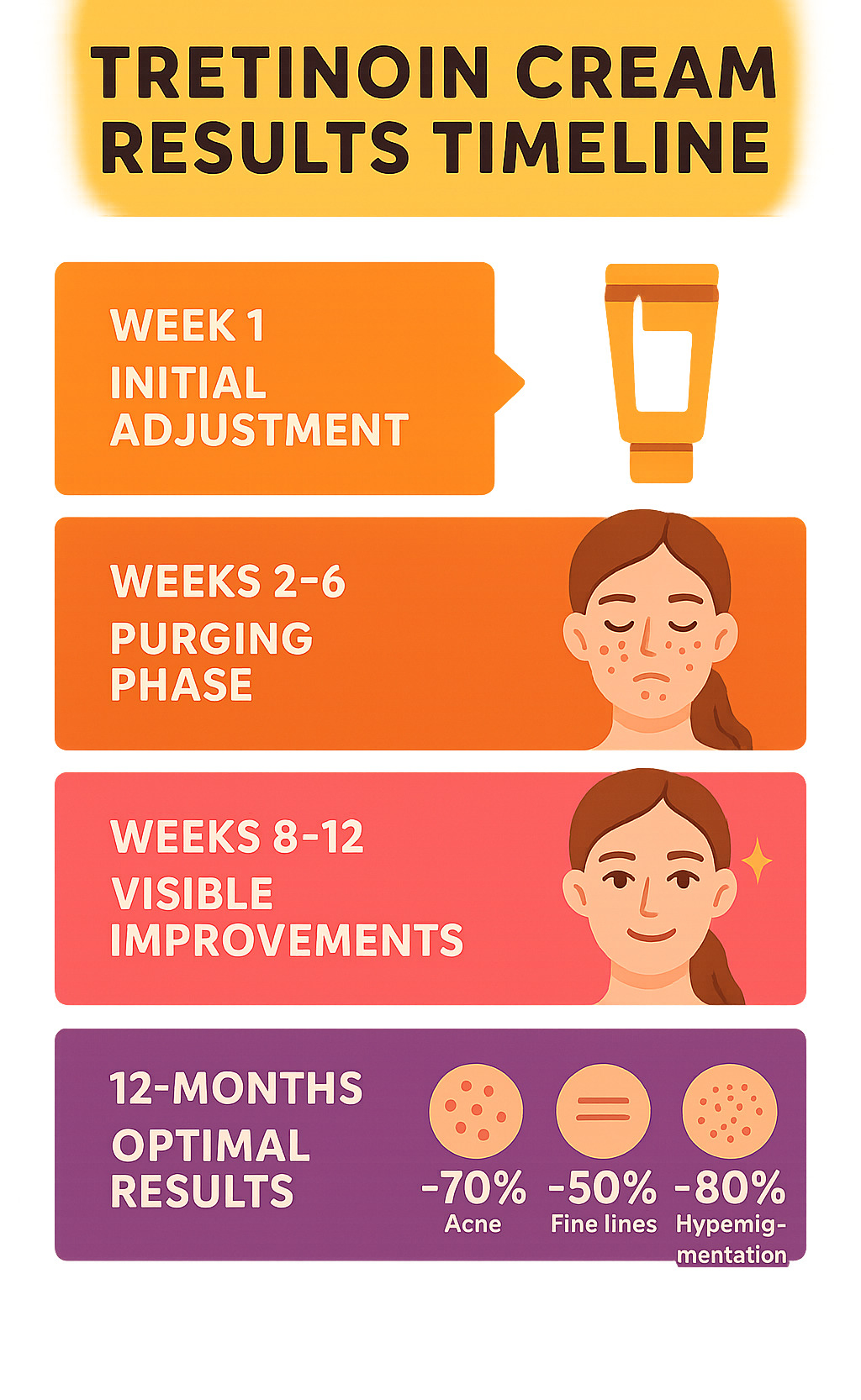
Easy tretinoin cream word list:
What Is Tretinoin Cream and How Does It Work?
Think of tretinoin cream as the overachiever in the retinoid family. While your typical drugstore retinol has to go through multiple conversions before your skin can actually use it, tretinoin arrives ready to work. It’s chemically known as all-trans-retinoic acid, which means it’s already in the exact form your skin cells recognize and respond to.
This head start makes tretinoin significantly more powerful than its over-the-counter cousins. When the FDA first approved tretinoin on October 20, 1971, they probably didn’t realize they were releaseing what would become dermatology’s most trusted workhorse. Over 50 years later, it remains the gold standard for good reason.
What sets tretinoin cream apart is its triple-threat approach. First, it performs something called comedolysis – basically breaking apart those stubborn blackheads and whiteheads while preventing new ones from forming. Second, it ramps up collagen production, which is why your skin starts looking plumper and smoother over time. Third, it helps repair photodamage from all those years of sun exposure we’d rather forget about.
Scientific research on retinoids and skin aging consistently shows tretinoin’s effectiveness for both acne and aging concerns. In fact, it’s the only retinoid that’s officially FDA-approved for treating signs of aging – not just acne.
Cellular Mechanism 101
Here’s where things get fascinating. Tretinoin cream works by binding to specific receptors in your skin cells called retinoic acid receptors. Think of these receptors as tiny locks, and tretinoin as the perfect key that fits right in.
Once tretinoin binds to these receptors, it triggers a cascade of cellular changes that speed up keratinocyte renewal. Your skin cells start turning over faster and more efficiently, like a well-oiled machine. The process decreases how sticky dead skin cells are to each other, which prevents them from clustering together and clogging your pores.
This leads to something called microcomedo extrusion – a fancy way of saying existing blackheads and whiteheads get pushed to the surface and naturally expelled. It’s like your skin is finally getting the deep clean it’s been craving.
Pharmacological Facts & Formulations
Tretinoin cream comes in three standard strengths: 0.025%, 0.05%, and 0.1%. Most people start with the lowest strength and work their way up as their skin builds tolerance. Gel formulations are also available, ranging from 0.01% to 0.1%, with some newer versions using microsphere technology to deliver the active ingredient more gently.
The microsphere technology is particularly clever – it creates tiny spheres that slowly release tretinoin over time, reducing irritation while maintaining effectiveness. It’s like having a time-release capsule for your skin.
One important safety note about gel formulations: they’re flammable and must be kept away from heat sources and open flames until completely dry on your skin. This is just one more reason why we always recommend applying tretinoin at bedtime and letting it fully absorb before you settle in for the night.
Benefits & Uses of Tretinoin Cream
Tretinoin cream is like having a Swiss Army knife for your skin – it tackles multiple concerns with impressive precision. What started as an acne treatment in the 1970s has evolved into dermatology’s most versatile prescription ingredient, addressing everything from stubborn breakouts to age spots and fine lines.
The beauty of tretinoin lies in its multitasking nature. You might begin your journey seeking clearer skin, only to find that your skin texture becomes smoother, your dark spots start fading, and those pesky fine lines around your eyes become less noticeable. It’s the kind of pleasant surprise that makes the initial adjustment period worthwhile.
For those dealing with melasma – those stubborn brown patches that seem impossible to fade – tretinoin often plays a starring role in treatment plans. The melasma overview from the American Academy of Dermatology highlights how tretinoin is frequently combined with other ingredients for optimal results.
Acne & Oil Control
When it comes to acne treatment, tretinoin cream works like a highly efficient cleaning crew for your pores. It prevents comedones from forming in the first place by keeping dead skin cells from clumping together and creating those frustrating blackheads and whiteheads.
But here’s where things get interesting – and sometimes frustrating. During your first few weeks of treatment, you might experience what dermatologists call the purging phase. Think of it as tretinoin doing some spring cleaning, bringing all those hidden comedones to the surface faster than your skin would naturally shed them.
This purging can feel discouraging when you’re hoping for clearer skin, but it’s actually a positive sign that the medication is working. Most people find that this phase lasts about 6-8 weeks before their skin starts looking significantly clearer and healthier.
Visible Anti-Aging Perks
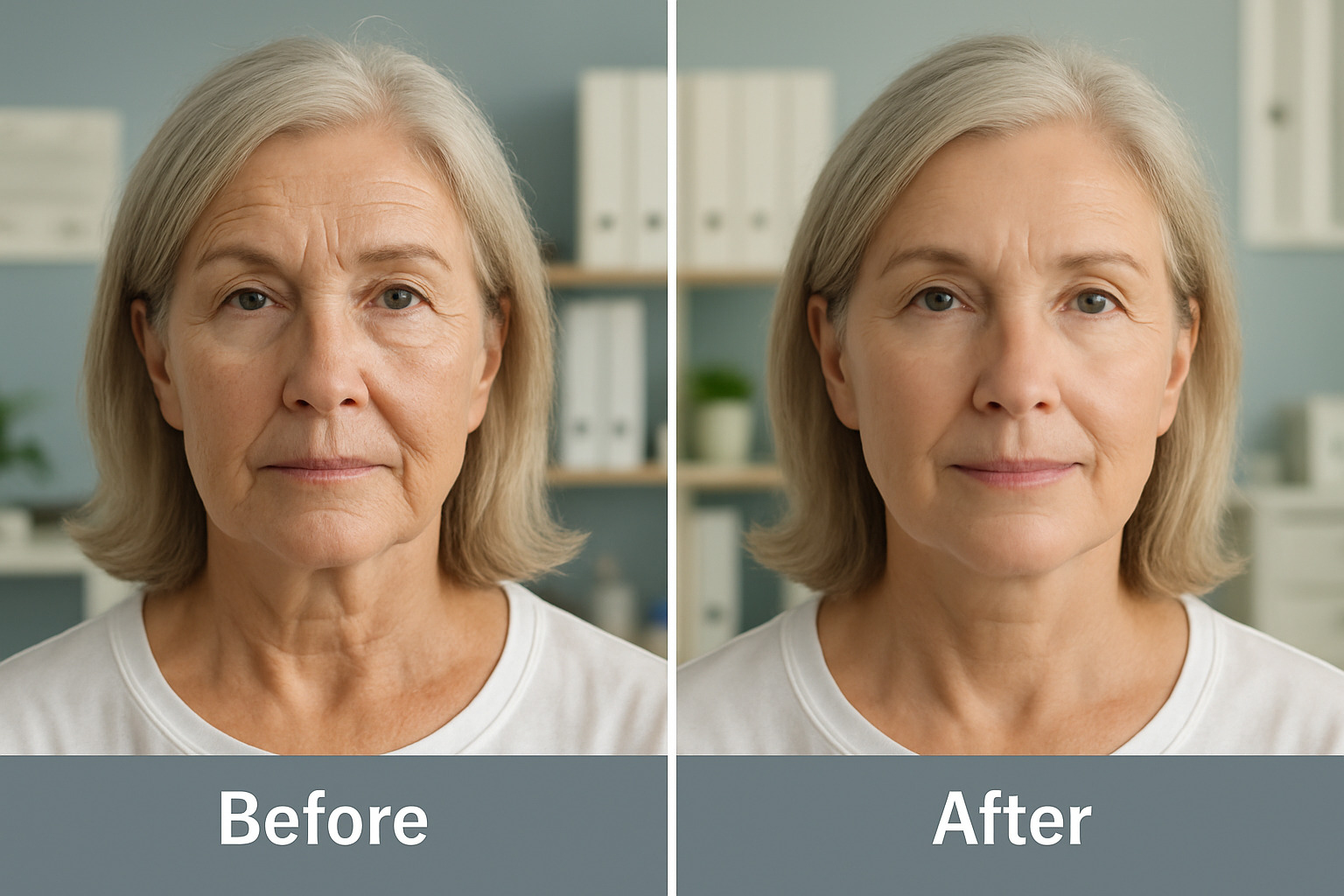
The anti-aging benefits of tretinoin are where this ingredient truly shines. By stimulating dermal collagen production and accelerating cell turnover, tretinoin helps your skin rebuild itself from the inside out. Fine lines become less pronounced, and your skin develops a firmer, more youthful texture.
The timing couldn’t be more crucial for women going through menopause. During this life stage, skin loses up to 30% of its dermal collagen in just the first five years, followed by an additional 2.1% loss each year. Tretinoin acts like a personal trainer for your skin cells, encouraging them to produce new collagen and maintain their strength.
The change isn’t instant – it’s more like watching a time-lapse video of a garden growing. Week by week, month by month, your skin gradually becomes more resilient, smoother, and more radiant.
Pigment & Tone Correction
Dark spots, post-inflammatory hyperpigmentation from old breakouts, and those telltale sunspots from years of beach vacations – tretinoin tackles them all with remarkable patience and persistence. The accelerated cell turnover acts like a gentle conveyor belt, bringing pigmented cells to the surface where they can naturally shed away.
The gradual fade process typically begins around 6-8 weeks of consistent use, with continued improvement stretching over many months. It’s not magic, but it’s pretty close – watching stubborn dark spots slowly lighten and blend with your natural skin tone is incredibly satisfying.
For those whose skin is too sensitive to handle tretinoin’s intensity, there are gentler options available. Our guide on Retinol Alternatives for Sensitive Skin Types explores effective alternatives that can provide similar benefits with less irritation.
How to Use Tretinoin Cream Safely & Effectively
Getting the most out of tretinoin cream isn’t just about slathering it on and hoping for the best. Think of it like learning to drive a sports car – you need to understand the rules of the road first, or you might end up with some unpleasant surprises.
The golden rules are surprisingly simple: bedtime application only, stick to the pea-sized rule for dosing, make sure your skin is bone dry before applying, and treat daily sunscreen like your new best friend. Missing any of these steps is like trying to bake a cake without following the recipe – technically possible, but probably not going to end well.
Here’s something that catches many people off guard: tretinoin makes your skin significantly more sensitive to UV damage. We’re talking about increased photosensitivity that can turn a casual walk to the mailbox into a sunburn situation. This means broad-spectrum sunscreen with SPF 30 or higher becomes as essential as brushing your teeth.
Weather considerations matter more than you’d think. During your first six months with tretinoin, your skin needs extra protection from wind, cold temperatures, and extreme weather conditions. Your skin barrier is essentially in training mode, learning to handle this powerful ingredient.
If you’re dealing with sensitive skin, our guide on Top Anti-Aging Products for Sensitive Skin offers great complementary products that play nicely with tretinoin.
Choosing the Right Strength of Tretinoin Cream
Starting with the wrong strength is like jumping into the deep end before learning to swim. Here’s how to wade in gradually:
New to tretinoin? Start with 0.025% strength. This isn’t the “weak” option – it’s the smart option. This concentration effectively treats acne and early aging signs while giving your skin time to adjust. Think of it as tretinoin with training wheels.
Once you’ve built tolerance over 3-6 months, you might graduate to 0.05% for intermediate users. This strength delivers improved anti-aging benefits without overwhelming your skin. It’s the sweet spot for many people long-term.
The 0.1% strength is reserved for tretinoin veterans who’ve successfully used lower concentrations and need maximum potency for stubborn skin concerns. This isn’t a race to the strongest formula – patience pays off.
Your titration schedule should move like a gentle slope, not a cliff. Start with every third night for the first week, then every other night for 2-3 weeks, finally building up to nightly use as your skin allows. Working with a dermatologist ensures you’re choosing the right strength and timeline for your unique skin needs.
Step-by-Step Application of Tretinoin Cream
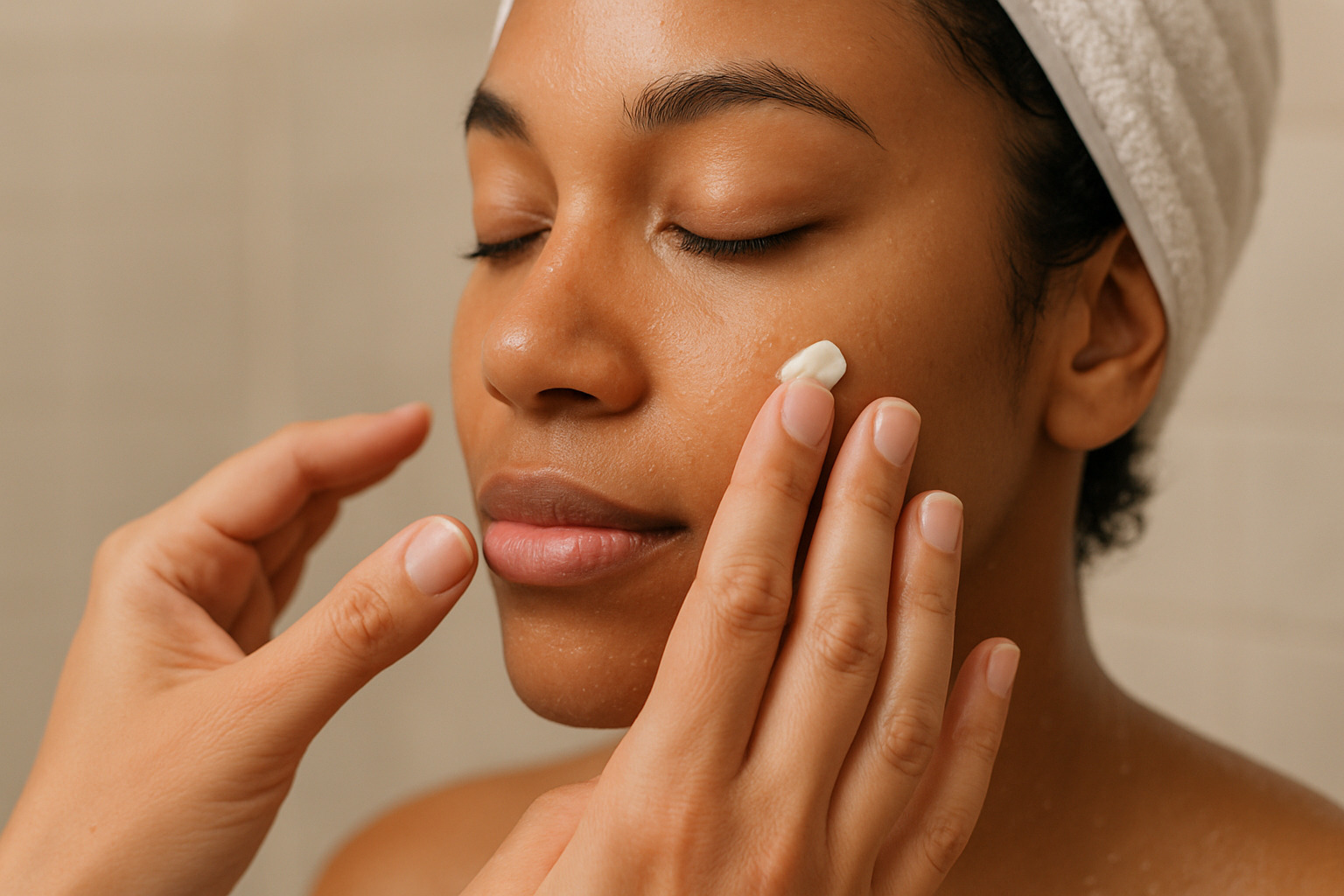
The application process is where many people go wrong, often because they’re eager to see results. Slow and steady wins this race.
Start with a double-cleanse using a gentle, non-medicated cleanser. Nothing fancy needed here – just clean skin free of makeup, sunscreen, and daily grime.
Here’s the step most people skip: wait 20-30 minutes for your skin to be completely dry. We mean desert-dry, not just towel-dried. Applying tretinoin to damp skin is like pouring gasoline on a fire – it amplifies irritation significantly.
When you’re ready to apply, use a pea-sized amount for your entire face. This seems impossibly small at first, but tretinoin spreads further than you’d expect. Avoid the delicate eye area, lips, and inside your nostrils.
If you’re experiencing irritation, try the sandwich method: apply a thin layer of moisturizer first, wait for it to absorb, then apply your tretinoin, followed by another layer of moisturizer. This buffering technique reduces irritation without significantly decreasing effectiveness.
Make tretinoin part of your bedtime routine – this medication should never see daylight on your skin. For more detailed guidance on building an effective routine, check out our article on How to Layer Serums and Moisturizers Correctly.
Side Effects & Irritation Hacks
Let’s be honest – tretinoin comes with a learning curve, and your skin will probably have some opinions about this new addition to your routine. Erythema (redness), peeling, dryness, and initial purging are all normal parts of what dermatologists call the “retinization” process.
Think of these side effects as your skin’s way of adjusting to increased cell turnover. It’s temporary, but it can feel overwhelming if you’re not prepared.
Moisturizer becomes your best friend during this adjustment period. Use a gentle, fragrance-free moisturizer both before and after tretinoin application. We’re talking about the boring, reliable moisturizers that don’t promise miracles – just solid hydration.
Rest nights are not cheating – they’re strategic. If irritation becomes excessive, take 1-2 nights off per week. Your skin will thank you, and you’ll actually see better long-term results than if you pushed through severe irritation.
During tretinoin treatment, avoid harsh products like exfoliating acids, alcohol-based toners, and abrasive scrubs. Your skin is already working overtime with cellular renewal – don’t pile on additional stressors.
Hydration from within matters too. Drink plenty of water and consider using a humidifier in dry climates. Your skin barrier needs all the support it can get during this adjustment period.
Here’s something important: don’t confuse purging with irritation. Purging happens in areas where you typically break out and resolves within 6-8 weeks as tretinoin cream brings deeper comedones to the surface. True irritation causes widespread redness, burning, and peeling that doesn’t improve with time and may require adjusting your routine.
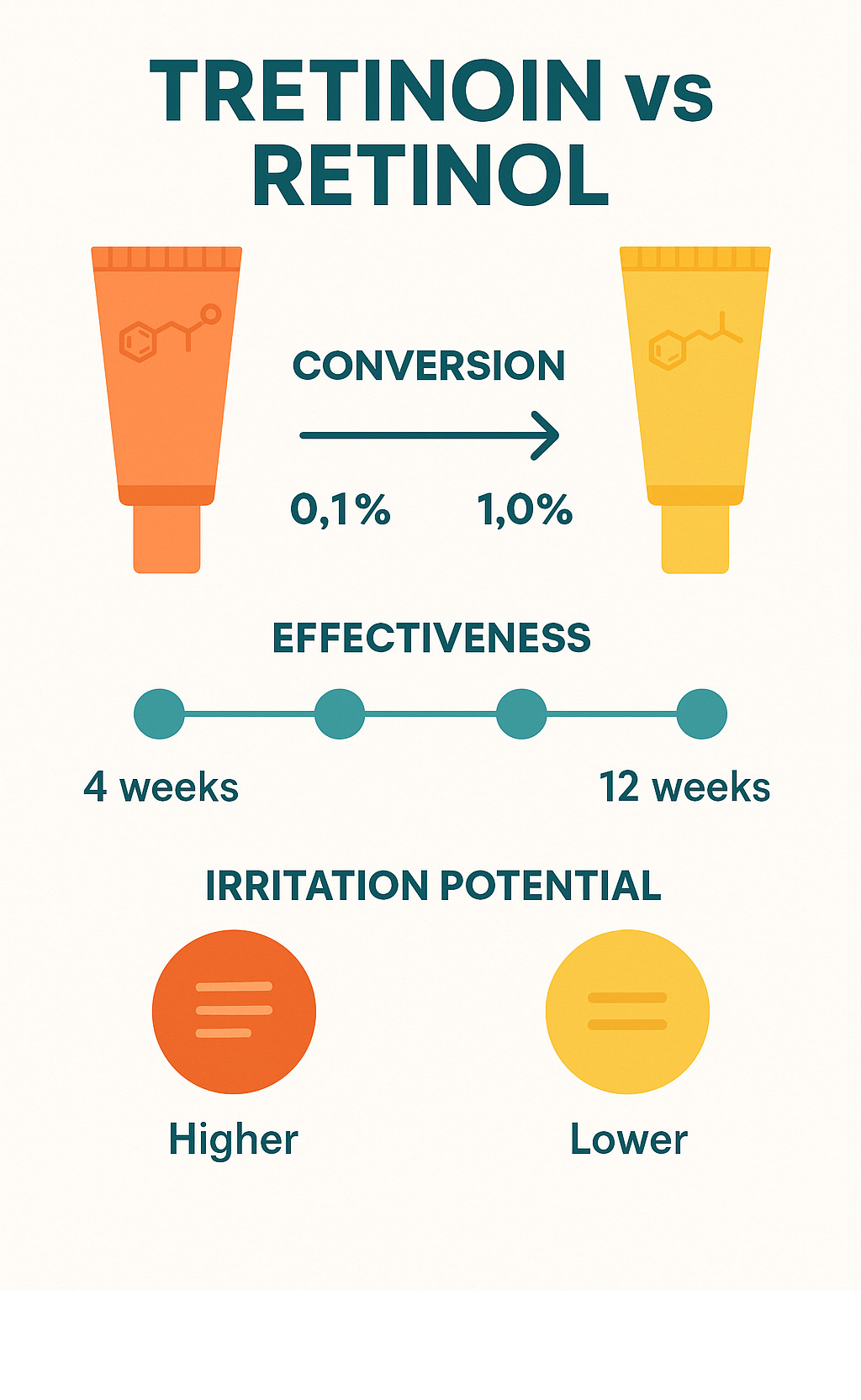
Access, Cost & Long-Term Considerations
Getting your hands on tretinoin cream used to mean jumping through hoops – scheduling appointments weeks in advance, taking time off work, and sitting in waiting rooms. The prescription-only status hasn’t changed, but telehealth has completely transformed the game.
Today’s virtual consultations make tretinoin more accessible than ever. You can connect with licensed dermatologists from your couch, discuss your skin concerns via video chat, and have your prescription delivered directly to your door. It’s a game-changer for busy schedules and those living in areas with limited dermatologist access.
Cost considerations vary widely depending on your insurance coverage and whether you opt for generic or brand-name formulations. A typical 3-month supply ranges from $30 to $90, with generic versions usually landing on the lower end of that spectrum. Many telehealth platforms charge around $40 for the initial consultation plus a small monthly support fee of about $3.
Pregnancy and breastfeeding require special attention when it comes to tretinoin use. The medication is contraindicated during pregnancy due to potential birth defects, and nursing mothers should use it with extreme caution. Always discuss family planning with your healthcare provider before starting treatment.
The good news about long-term safety? Decades of research and clinical use have established tretinoin’s excellent safety profile for extended use. Many dermatologists consider it one of the safest long-term skincare treatments available when used properly.
Maintenance dosing becomes relevant once you’ve achieved your desired results. Many people successfully transition from nightly use to every other night or even a few times per week. This approach helps maintain benefits while reducing costs and potential irritation.
For those dealing with acne alongside other skin concerns, our comprehensive guide on Skincare for Acne-Prone Skin offers valuable insights to complement your tretinoin routine.
Combining Tretinoin With Other Actives
Strategic ingredient pairing can amplify tretinoin’s benefits, but timing is absolutely crucial. Think of it like conducting an orchestra – every ingredient needs to play at the right moment to create harmony instead of chaos.
Benzoyl peroxide timing requires careful choreography. Use it in your morning routine if you’re applying tretinoin at night. Never layer them simultaneously, as this combination can cause severe irritation that’ll have you looking like a lobster.
Hydroquinone cycles work beautifully with tretinoin for stubborn pigmentation issues like melasma. Dermatologists often prescribe them together in 3-4 month cycles, followed by a rest period to prevent potential side effects.
Niacinamide synergy is one of the happiest skincare marriages we’ve seen. This gentle ingredient actually helps reduce tretinoin irritation while maintaining its effectiveness. It’s like having a supportive friend who makes you look better without stealing the spotlight.
Avoid AHAs on the same nights as your tretinoin application. Glycolic acid, salicylic acid, and other exfoliating acids should be scheduled for alternate evenings to prevent over-exfoliation and irritation.
The golden rule for any new combination is patch testing. Introduce one new product at a time and give your skin at least a week to adjust before adding anything else. Your skin will thank you for the patience.
Frequently Asked Questions about Tretinoin
How long until I see results?
This is the question we hear most often, and honestly, it’s the hardest part about starting tretinoin cream – the waiting game. Your skin doesn’t transform overnight, but the changes happen in predictable stages that are worth understanding.
The first 2-3 weeks are all about microscopic changes happening beneath the surface. Your skin cells are learning to turn over faster, but you probably won’t see much difference in the mirror yet. This is when many people wonder if the tretinoin is even working.
Around 6-8 weeks, you’ll start noticing your skin feels smoother and looks more radiant. Small improvements in texture and tone become apparent, though major concerns like deep acne or significant sun damage will still be hanging around.
The 12-week mark is when tretinoin really starts to show off. This is when you’ll see visible reduction in acne breakouts, softening of fine lines, and noticeable fading of dark spots. Most clinical studies measure tretinoin success at this three-month point.
Between 6-12 months of consistent use is when you’ll achieve optimal results. Your skin will continue improving, with many people reporting their best results after a full year of regular use. Improvement may take longer than 12 weeks even with daily use – patience truly is your best friend with tretinoin.
Can I miss a dose or accidentally apply too much?
Life happens, and sometimes you’ll forget your tretinoin cream or accidentally squeeze out way more than that pea-sized amount. Here’s what to do in both situations.
If you miss a dose, simply skip it and resume your regular schedule the next night. The biggest mistake people make is trying to “catch up” by applying extra the following night. This doesn’t speed up results – it just increases your risk of irritation.
If you accidentally apply too much, don’t panic or try to scrub it off. Gently blot away any excess with a soft, clean cloth and apply a soothing moisturizer over the area. You might experience some extra redness, dryness, or peeling for the next few days, but this will resolve on its own.
The key is getting back to your regular routine without overcompensating. Your skin responds better to consistent, gentle treatment than to dramatic corrections.
Who should avoid tretinoin cream altogether?
While tretinoin is generally safe for most people, there are some situations where it’s best to avoid it entirely or wait until circumstances change.
Pregnant or breastfeeding women should steer clear of tretinoin due to potential teratogenic effects. The risk to developing babies isn’t worth it, and there are safer alternatives available during this time.
People with active eczema flares should wait until their skin calms down before starting tretinoin. The medication can worsen inflammatory skin conditions, making an already uncomfortable situation much worse.
If you have severe sunburn, hold off on tretinoin until your skin is completely healed. Applying it to already damaged skin is like adding fuel to a fire.
Those with known allergies to tretinoin or any ingredients in the formulation should obviously avoid it. If you’ve had reactions to other retinoids, discuss this thoroughly with your healthcare provider before trying tretinoin.
The bottom line? Always consult with a healthcare provider before starting tretinoin cream, especially if you have sensitive skin, existing skin conditions, or other medical concerns. They can help determine if tretinoin is right for your specific situation and skin type.
Conclusion
After nearly 50 years of dermatological research, tretinoin cream stands as the undisputed champion of prescription skincare. What makes it so special? It’s the only topical treatment that tackles acne, aging, and hyperpigmentation all at once – backed by decades of scientific proof.
The secret to tretinoin success isn’t complicated, but it does require commitment. Consistent use is your best friend here. We’re talking about showing up for your skin every single night (well, almost every night – those rest days are important too). The adjustment period can feel like a skincare boot camp, but trust us, your future self will thank you.
Let’s be real about the sun protection mantra – it’s absolutely non-negotiable when you’re using tretinoin. Think of sunscreen as tretinoin’s bodyguard. Without it, you’re essentially undoing all the good work this powerhouse ingredient is doing for your skin. Daily SPF isn’t just a suggestion; it’s the difference between tretinoin success and tretinoin regret.
Patience might be the hardest part of the tretinoin journey. In our instant-gratification world, waiting 12 weeks for visible results feels like forever. But here’s the thing – healthy skin really is a marathon, not a sprint. Those first few weeks of potential purging and peeling? They’re not punishment; they’re progress.
Whether you started this journey to combat stubborn acne, smooth fine lines, or fade dark spots, tretinoin delivers on its promises. The initial weeks might test your resolve, but the long-term payoff – clearer, smoother, more radiant skin – makes every slightly flaky morning worth it.
At Beyond Beauty Lab, we believe knowledge is power when it comes to skincare. Your tretinoin cream trip is just one part of building a complete, thoughtful approach to skin health. For more info about healthy skin routines, explore our comprehensive resource hub where we break down everything from ingredient science to routine building.
Tretinoin isn’t just about fixing current skin concerns – it’s an investment in your skin’s future. With proper use, realistic expectations, and that all-important daily sunscreen habit, you’re setting yourself up for decades of healthier, happier skin. Trust the process, accept the journey, and get ready to fall in love with what nearly five decades of dermatological innovation can do for your complexion.

